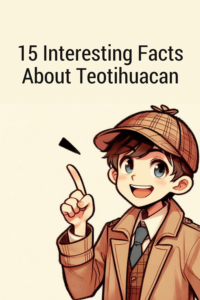Introduction:
Teotihuacán, located in present-day Mexico, is one of the most enigmatic ancient cities in the world. This Mesoamerican marvel has perplexed archaeologists and historians for centuries, with its burstiness of culture, architecture, and rituals. In this article, we will delve into 15 fascinating facts about Teotihuacán that will leave you in awe of this ancient civilization.
Fact 1: The City Layout
The layout of Teotihuacán is incredibly intricate, with a grid system of streets and avenues leading to monumental structures such as the Pyramid of the Sun and the Pyramid of the Moon. The city covers a vast area and was meticulously planned, indicating a high level of organization and urban planning.
Fact 2: The Pyramid of the Sun
The Pyramid of the Sun is the largest pyramid at Teotihuacán and one of the largest in Mesoamerica. It is thought to have been constructed in the 2nd century AD and served as a ceremonial and religious center for the city. The sheer size and scale of the pyramid are a testament to the engineering prowess of the Teotihuacán people.
Fact 3: Avenue of the Dead
The Avenue of the Dead is a central thoroughfare that runs through the heart of Teotihuacán, connecting the Pyramid of the Moon to the Pyramid of the Sun. It is flanked by temples, palaces, and residential complexes, giving insight into the daily life of the ancient residents of the city.
Fact 4: The Temple of the Feathered Serpent
The Temple of the Feathered Serpent, also known as the Temple of Quetzalcoatl, is a stunning example of Mesoamerican art and architecture. The temple is adorned with intricate carvings of feathered serpents and other mythological creatures, showcasing the artistic skill of the Teotihuacán people.
Fact 5: The Murals of Teotihuacán
Teotihuacán is renowned for its vibrant and detailed murals, which adorn the walls of temples, palaces, and residential buildings. These murals depict scenes of daily life, ceremonial rituals, and mythological figures, offering a glimpse into the cultural and religious beliefs of the Teotihuacán civilization.
Fact 6: The Teotihuacán Writing System
Although the Teotihuacán civilization did not have a fully developed writing system like the Maya, they did use symbols and glyphs to communicate and record information. These symbols are found on murals, pottery, and other artifacts throughout the city, providing valuable insights into the language and communication of the ancient Teotihuacán people.
Fact 7: The Obsidian Industry
Teotihuacán was a major center for the production and distribution of obsidian, a volcanic glass prized for its sharpness and durability. The city had a thriving obsidian industry, with workshops dedicated to the manufacture of tools, weapons, and ceremonial objects made from this valuable material.
Fact 8: The Tunnel Beneath the Temple of the Feathered Serpent
In 2003, archaeologists discovered a secret tunnel beneath the Temple of the Feathered Serpent, leading to a chamber filled with offerings and artifacts. This tunnel, known as the Tunnel of the Dead, provided new insights into the religious practices and beliefs of the Teotihuacán people.
Fact 9: The Sacrificial Burials
Numerous sacrificial burials have been uncovered at Teotihuacán, revealing the religious and ritualistic practices of the ancient civilization. These burials often include human remains, animal sacrifices, and valuable offerings, shedding light on the beliefs and customs of the Teotihuacán people.
Fact 10: The Residential Complexes
Teotihuacán was home to a diverse population of residents, including priests, artisans, farmers, and rulers. The city contained numerous residential complexes, each with its own courtyard, living quarters, and storage facilities. The layout of these complexes reflects the social hierarchy and organization of Teotihuacán society.
Fact 11: The Water System
Despite being located in a semi-arid region, Teotihuacán had a sophisticated water management system that supplied the city with fresh water for drinking, irrigation, and ceremonial purposes. This system consisted of aqueducts, reservoirs, and canals that collected and distributed water throughout the city.
Fact 12: The Avenue of the Dead Alignment
The Avenue of the Dead is aligned with significant celestial events, such as the setting sun on certain dates during the year. This alignment suggests that the layout of Teotihuacán was designed with astronomical knowledge and religious significance in mind, linking the city to the cosmos.
Fact 13: The Pyramid of the Moon Construction
The construction of the Pyramid of the Moon involved a massive labor force and intricate engineering techniques. The pyramid is thought to have been built in multiple stages, with each successive layer adding to the height and grandeur of the structure. The Pyramid of the Moon served as a symbolic representation of the female deity in Teotihuacán religion.
Fact 14: The Decline of Teotihuacán
Despite its monumental scale and architectural achievements, Teotihuacán experienced a rapid decline and eventual abandonment in the 7th century AD. The reasons for this decline remain a mystery, with theories ranging from internal unrest to environmental factors such as drought and famine.
Fact 15: The Legacy of Teotihuacán
The legacy of Teotihuacán lives on in the cultural heritage of Mexico and the world. The city’s monumental pyramids, vibrant murals, and intricate carvings continue to inspire awe and fascination, drawing visitors from around the globe to marvel at the achievements of this ancient civilization.
Conclusion
In conclusion, the Teotihuacán enigma continues to captivate and mystify scholars and visitors alike with its burstiness of culture, architecture, and rituals. The 15 fascinating facts about Teotihuacán presented in this article only scratch the surface of the rich history and significance of this remarkable ancient city. As we delve deeper into the mysteries of Teotihuacán, we discover a civilization that defies easy categorization and invites us to explore the complexities of the past.
Subscribe to our email newsletter to get the latest posts delivered right to your email.




Comments